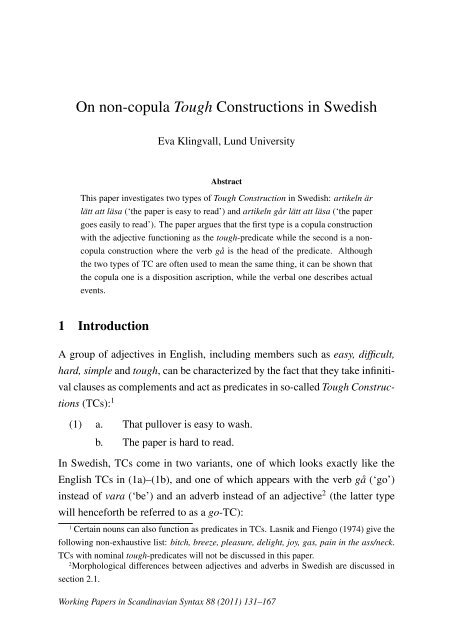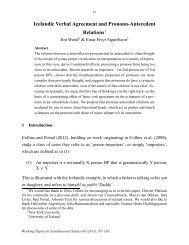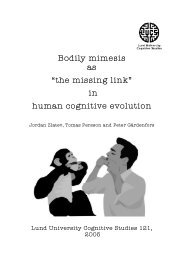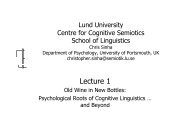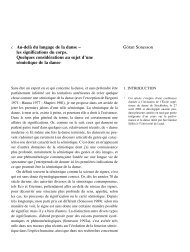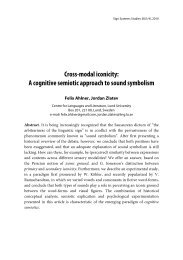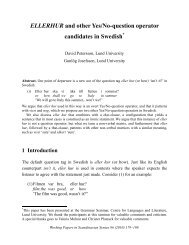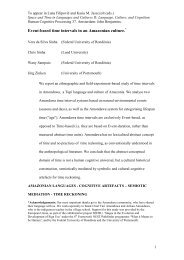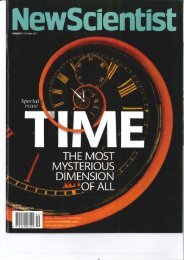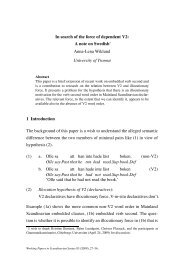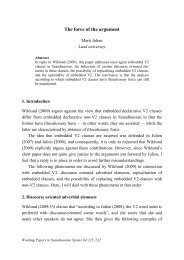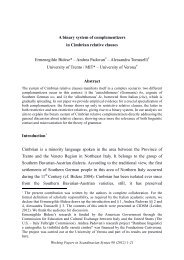Eva Klingvall On non-copula Tough Constructions in Swedish (PDF ...
Eva Klingvall On non-copula Tough Constructions in Swedish (PDF ...
Eva Klingvall On non-copula Tough Constructions in Swedish (PDF ...
You also want an ePaper? Increase the reach of your titles
YUMPU automatically turns print PDFs into web optimized ePapers that Google loves.
<strong>On</strong> <strong>non</strong>-<strong>copula</strong> <strong>Tough</strong> <strong>Constructions</strong> <strong>in</strong> <strong>Swedish</strong><strong>Eva</strong> <strong>Kl<strong>in</strong>gvall</strong>, Lund UniversityAbstractThis paper <strong>in</strong>vestigates two types of <strong>Tough</strong> Construction <strong>in</strong> <strong>Swedish</strong>: artikeln ärlätt att läsa (‘the paper is easy to read’) and artikeln går lätt att läsa (‘the papergoes easily to read’). The paper argues that the first type is a <strong>copula</strong> constructionwith the adjective function<strong>in</strong>g as the tough-predicate while the second is a <strong>non</strong><strong>copula</strong>construction where the verb gå is the head of the predicate. Althoughthe two types of TC are often used to mean the same th<strong>in</strong>g, it can be shown thatthe <strong>copula</strong> one is a disposition ascription, while the verbal one describes actualevents.1 IntroductionA group of adjectives <strong>in</strong> English, <strong>in</strong>clud<strong>in</strong>g members such as easy, difficult,hard, simple and tough, can be characterized by the fact that they take <strong>in</strong>f<strong>in</strong>itivalclauses as complements and act as predicates <strong>in</strong> so-called <strong>Tough</strong> <strong>Constructions</strong>(TCs): 1(1) a. That pullover is easy to wash.b. The paper is hard to read.In <strong>Swedish</strong>, TCs come <strong>in</strong> two variants, one of which looks exactly like theEnglish TCs <strong>in</strong> (1a)–(1b), and one of which appears with the verb gå (‘go’)<strong>in</strong>stead of vara (‘be’) and an adverb <strong>in</strong>stead of an adjective 2 (the latter typewill henceforth be referred to as a go-TC):1Certa<strong>in</strong> nouns can also function as predicates <strong>in</strong> TCs. Lasnik and Fiengo (1974) give thefollow<strong>in</strong>g <strong>non</strong>-exhaustive list: bitch, breeze, pleasure, delight, joy, gas, pa<strong>in</strong> <strong>in</strong> the ass/neck.TCs with nom<strong>in</strong>al tough-predicates will not be discussed <strong>in</strong> this paper.2Morphological differences between adjectives and adverbs <strong>in</strong> <strong>Swedish</strong> are discussed <strong>in</strong>section 2.1.Work<strong>in</strong>g Papers <strong>in</strong> Scand<strong>in</strong>avian Syntax 88 (2011) 131–167
1342 Similarities and differencesTCs and go-TCs behave <strong>in</strong> the same way <strong>in</strong> many respects. Like their Englishcounterparts, for <strong>in</strong>stance, both types have alternative versions wherethe subject is either expletive or clausal:(6) a. Detitb. Detitc. Atttod. Atttoärislätt att läsa böckerna.easy to read books-DEF‘It is easy to read the books.’går lätt att läsa böckerna.goes easily to read books-DEF‘It is easy to read the books.’läsa böckerna är lätt.read books-DEF is easy‘To read the books is easy.’läsa böckerna går lätt.read books-DEF goes easily‘To read the books is easy.’Furthermore, both types have an implicit Experiencer argument that can beovertly expressed via a för-phrase (‘for’-phrase):(7) a. Artikelnpaper-DEFärislätt för vem som helst att läsa.easy for anyone to read‘The paper is easy for anyone to read.’b. Artikelnpaper-DEFgår lätt för mig att läsa.goes easily for me to read‘The paper is easy for me to read.’TCs and go-TCs also behave the same with respect to wh-movement, longdistance dependencies and parasitic gaps, as will be shown <strong>in</strong> section 3.3.Crucially, neither of the types can be reduced to a rais<strong>in</strong>g construction.Although TCs and go-TCs are very similar <strong>in</strong> mean<strong>in</strong>g and surface form,the constructions also differ <strong>in</strong> some <strong>in</strong>terest<strong>in</strong>g respects. As will be shownbelow, go-TCs are subject to a number of restrictions not apply<strong>in</strong>g to TCs.In the next two sections, I discuss what adjectives and adverbs are found <strong>in</strong>
135the constructions, and what embedded verbs they allow. In sections 2.3–2.5,I turn to syntactic differences.2.1 Adjectives and adverbsBefore look<strong>in</strong>g at what particular types of adjectives and adverbs can appear<strong>in</strong> the two constructions, I give a brief <strong>in</strong>troduction to the morphological differencesbetween adjectives and adverbs <strong>in</strong> <strong>Swedish</strong>.Adjectives <strong>in</strong> <strong>Swedish</strong> agree morphologically with the noun they modifyor predicate over, show<strong>in</strong>g a gender dist<strong>in</strong>ction <strong>in</strong> the s<strong>in</strong>gular (common orneuter), and appear<strong>in</strong>g with a designated marker for plural: 3(8) a. Flickangirl-DEFärislång.‘The girl is tall.’b. Barnetchild-DEFäristall-COMMONlångt.‘The child is tall.’c. Flickorna/Barnentall-NEUTERgirl-PL.DEF/child-PL.DEF‘The girls/children are tall.’är långa.are tall-PLAdverbs, on the other hand, have an <strong>in</strong>variable form end<strong>in</strong>g <strong>in</strong> -t:(9) a. Flickangirl-DEFsprangranlångt.long‘The girl ran a long way.’b. Barnetchild-DEFsprangranlångt.long‘The child ran a long way.’c. Flickorna/Barnengirls-PL.DEF/child-PL.DEFsprangran‘The girls/children ran a long way.’långt.long3Gender and number on the adjective are not glossed elsewhere <strong>in</strong> the paper.
136When the adjective appears <strong>in</strong> the neuter s<strong>in</strong>gular form, it is morphologically<strong>in</strong>dist<strong>in</strong>guishable from the correspond<strong>in</strong>g adverb, as seen <strong>in</strong> (9b)–(9c). Themorphological dist<strong>in</strong>ction between adjectives and adverbs is also obscured forsome adjectives whose stem ends <strong>in</strong> -t, such as lätt (‘easy’). These adjectiveshave the same form for both genders <strong>in</strong> the s<strong>in</strong>gular, and this form is moreoveridentical to the correspond<strong>in</strong>g adverb:(10) a. en lätt bok/ett lätt probleman easy book-DEF/an easy problem‘an easy book/an easy problem.’b. Snö smälter lätt i varmt väder.snow melts easily <strong>in</strong> warm weather‘Snow melts easily <strong>in</strong> warm weather.’For TCs and go-TCs, thus, a morphological difference between the adjectiveand adverb is found with plural subjects, (11a)–(11b), and (except for lätt)with s<strong>in</strong>gular subjects <strong>in</strong> the common gender, (11c)–(11d):(11) a. Böckernabooks-DEFär lätta att läsa.are easy to read‘The books read slowly.’b. Böckernabooks-DEFgårgolätt att läsa.slowly to read‘The books read slowly.’c. Bokenbook-DEFäriströg att läsa.slow to read‘The book is slow to read.’d. Bokenbook-DEFgår trögt att läsa.goes slowly to read‘The book reads slowly.’Not all adjectives and adverbs can appear <strong>in</strong> these constructions. In thecase of TCs, the adjective is subject to a thematic restriction. More precisely,adjectives that assign a thematic role to their subject and consequently cannotappear with an expletive subject do not count as tough-adjectives (see Lasnik
137and Fiengo, 1974). Lätt (‘easy’) but not vacker (‘beautiful’) is thus a TCadjective:(12) a. Bokenb. Detitbook-DEFärislätt att läsa.easy to read‘The book is easy to read.’ärislätt att läsa boken.easy to read book-DEF‘It is easy to read the book.’c. Musikend. * Detitmusic-DEFärisvacker att lyssna på.beautiful to listen to‘The music is beautiful to listen to.’ärisvackert att lyssna på musiken.beautiful to listen to music-DEFThis issue does not arise for go-TCs. That is to say, there are no constructionsthat look like go-TCs but which cannot alternate with an expletive subject.The pattern <strong>in</strong> (12c)–(12d) is thus not found with adverb+gå. Go-TCs arerestricted <strong>in</strong> another way, however. The permissible adverbs are restricted toone semantic class:(13) Boken går lätt/tungt/trögt/enkelt/snabbt/långsamt/book-DEF goes easily/heavily/slowly/simply/fast/slowly/bra/dåligt att läsa.well/badly to read‘The book is easy/heavy/slow/simple/fast/slow/easy/difficult to read.’The adverbs <strong>in</strong> (13) all refer to how easy (or not) it is to do someth<strong>in</strong>g withthe entity <strong>in</strong> the subject position. These adverbs correspond to a group of adjectivesreferred to as expense-type modifiers (see Foldvik, 1989; Kim, 1995).Such modifiers describe “how much time, money or effort an event requiresfrom someone who is participat<strong>in</strong>g <strong>in</strong> the event as an agent” (Kim, 1995,273). Notably, even adverbs such as well and badly get this <strong>in</strong>terpretation, ascan be seen <strong>in</strong> the translation <strong>in</strong> (13). With the exception of snabbt (‘fast’)and långsamt (‘slowly’), all the adverbs <strong>in</strong> (13) have correspond<strong>in</strong>g adjectival
138forms appear<strong>in</strong>g <strong>in</strong> TCs. 4,5(14) Bokenbook-DEFärislätt/tung/trög/enkel/bra/dålig att läsa.easy/heavy/slow/easy/good/bad to read‘The book is easy/heavy/slow/easy/good/bad to read.’Adjectival TCs are however more liberal than go-TCs <strong>in</strong> allow<strong>in</strong>g not onlyexpense-type predicates, but also, for <strong>in</strong>stance, psych-type predicates. Thelatter describe “a psychological state that a fact or an event causes an <strong>in</strong>dividualto experience” (Kim, 1995, 274) (see also Foldvik, 1989): 6(15) Bokenbook-DEFatt läsa.to readärisrolig/sorglig/trist/<strong>in</strong>tressant/långtråkig/fun/sad/bor<strong>in</strong>g/<strong>in</strong>terest<strong>in</strong>g/bor<strong>in</strong>g/stimulerandestimulat<strong>in</strong>g‘The book is fun/sad/bor<strong>in</strong>g/<strong>in</strong>terest<strong>in</strong>g/stimulat<strong>in</strong>g to read.’(16) * Boken går roligt/sorgligt/trist/<strong>in</strong>tressant/långtråkigt/book-DEF goes funnily/sadly/bor<strong>in</strong>gly/<strong>in</strong>terest<strong>in</strong>gly/bor<strong>in</strong>gly/stimulerande att läsa.stimulat<strong>in</strong>gly to readWhile both expense- and psych-type predicates relate to an implied Agent,only the psych-ones explicitly say that the Agent is affected by the action.In section 3, I return to the question of why go-TCs only allow expense-typepredicates.4The adjectives snabb and långsam cannot appear with expletive subjects and therefore donot count as TC adjectives, see section 2.1 above.5The adjectives lätt, svår, snabb, trög, tung are found also <strong>in</strong> constructions with complexdispositional adjectives, CDAs (see <strong>Kl<strong>in</strong>gvall</strong>, 2008, To appear):(1) Bokenbookär lätt-/svår-/snabb-/trög-/tungläst.is easy/difficult/fast/slow/heavy.read-PPTCThe book is easy/difficult/fast/slow/heavy to read.’Interest<strong>in</strong>gly, CDAs are similar to go-TC <strong>in</strong> be<strong>in</strong>g restricted to hav<strong>in</strong>g only these particularadjectives <strong>in</strong> their left-hand position. With regard to their mean<strong>in</strong>g, constructions with CDAsare furthermore similar to both TCs and go-TCs, as can be seen <strong>in</strong> the translation above.6Psych-type adjectives correspond closely to the Experiencer verbs discussed by Pesetsky(1987). As mentioned <strong>in</strong> section 1, some but not all Experiencer verbs are tough-predicates<strong>in</strong> <strong>Swedish</strong>.
1392.2 The embedded verb and its argumentsBoth TCs and go-TCs are formed productively. S<strong>in</strong>ce the subject is an underly<strong>in</strong>gobject, however, only verbs that take objects can appear <strong>in</strong> the constructions.TCs and go-TCs can thus embed a verb like spr<strong>in</strong>ga (‘run’) only if itco-occurs with an underly<strong>in</strong>g object <strong>in</strong> the matrix subject position (and not onits unergative use):(17) a. * Per är lätt att spr<strong>in</strong>ga.Per is easy to runb. * Per går lätt att spr<strong>in</strong>ga.Per goes easily to runc. Denthatd. Denthatrundantrack-DEFärislätt att spr<strong>in</strong>ga.easy to run‘That track is easy to run.’rundantrack-DEF‘That track is easy to run.’går lätt att spr<strong>in</strong>ga.goes easily to runThe presence of an <strong>in</strong>ternal object <strong>in</strong> the subject position is a necessary butnot sufficient criterion. In addition to an <strong>in</strong>ternal argument, the embeddedverbs must also have an external argument, syntactically realized as PRO.Unaccusative verbs, therefore, do not appear <strong>in</strong> these constructions, unliketheir causative counterparts:(18) a. Båtenboat-DEFb. Båtenärislätt att sänka/*sjunka.easy to s<strong>in</strong>k-CAUS/s<strong>in</strong>k-INCH‘The boat is easy to s<strong>in</strong>k.’boat-DEFgår lätt att sänka/*sjunka.goes easily to s<strong>in</strong>k-CAUS/s<strong>in</strong>k-INCH‘The boat is easy to s<strong>in</strong>k.’As illustrated, both TCs and go-TCs thus select <strong>in</strong>f<strong>in</strong>itival clauses with transitiveverbs. Go-TCs, however, have a further requirement: the embeddedverb must have an external argument that is specifically an Agent. Verbs withExperiencer subjects, such as störa sig på (‘get annoyed at’) <strong>in</strong> (19), and falla
140för (‘fall for’) <strong>in</strong> (20), and verbs with Recipient subjects, such as ta emot(‘receive’) <strong>in</strong> (21), are thus <strong>in</strong>felicitous:(19) a. Per är lätt PRO Exp att störa sig på.Per is easy to annoy REFL on‘Per is easy to get annoyed at.’b. ?? Per går lätt PRO Exp att störa sig på.Per goes easily to annoy REFL on(20) a. Denthatb. ?? Denthat(21) a. Denthatb. ?? Denthat‘Per is easy to get annoyed at.’frestelsentemptation-DEFärislätt PRO Exp att falla för.easy to fall for‘That temptation is easy to give <strong>in</strong> to.’frestelsentemptation-DEFgår lätt PRO Exp att falla för.goes easily to fall for‘That temptation is easy to give <strong>in</strong> to.’gåvangift-DEFäris‘That gift is easy to receive.’gåvangift-DEFlätt PRO Rec att ta emot.easy to receivegår lätt PRO Rec att ta emot.goes easily to receive‘That gift is easy to receive.’The sentences <strong>in</strong> (19b), (20b) and (21b) are well-formed only to the extentthat the verbs <strong>in</strong> the <strong>in</strong>f<strong>in</strong>itival clauses can get an agentive <strong>in</strong>terpretation, i.e.with PRO <strong>in</strong>terpreted as an Agent. No such coercion is necessary <strong>in</strong> the TC.2.3 Small clausesIntuitively, both TCs and go-TCs express properties that consist of the adjectiveor adverb <strong>in</strong> comb<strong>in</strong>ation with the <strong>in</strong>f<strong>in</strong>itival clause. This is syntacticallytransparent <strong>in</strong> the TC but not <strong>in</strong> the go-TC. That is, <strong>in</strong> the TC the adjectivecan be shown to take the <strong>in</strong>f<strong>in</strong>itival clause as its syntactic complement and theunderly<strong>in</strong>g object as its subject. The subject-predicate relation is here analyzedas mediated via the adjectival functional head, a, an <strong>in</strong>stantiation of the
141general phonologically null Pred head, proposed by Bowers (1993) (see alsoAdger and Ramchand, 2003):(22) a. JagIanser de böckerna (vara) tröga att läsa.consider those books-DEF (be) slow to read‘I consider those books (be) slow to read.’b. [ aP de böckerna Pred [ AP tröga [ CP att läsa]]]As <strong>in</strong>dicated <strong>in</strong> (22a), the small clause may also optionally conta<strong>in</strong> the <strong>in</strong>f<strong>in</strong>itivalform of vara (‘be’). 7In contrast to the TC-adjective, the adverb <strong>in</strong> the go-TC does not form asmall clause predicate with the <strong>in</strong>f<strong>in</strong>itival clause. The sentence seems to improvewith an <strong>in</strong>f<strong>in</strong>itival form of gå, but some speakers still f<strong>in</strong>d it ill-formed:(23) a. * JagIb. ?? JagIanser de böckerna trögt att läsa.consider those books-DEF slowly to readanser de böckerna gå trögt att läsa.consider those books-DEF go slowly to read‘I consider those books slow to read.’c. * [ aP de böckerna Pred [ AdvP trögt [ CP att läsa]]]The adjective <strong>in</strong> the TC and the adverb <strong>in</strong> the go-TC, then, have differentstatus <strong>in</strong> the constructions.2.4 Question-formationTCs and go-TCs also differ <strong>in</strong> what str<strong>in</strong>gs they allow to move to the sentence<strong>in</strong>itial position <strong>in</strong> questions. In both TCs and go-TCs, the adjective or adverbcan move on its own to this position:(24) a. Hur tröga är de böckerna att läsa?how slow are those books-DEF to read‘How slow to read are those books?’b. (?) Hur trögt går de böckerna att läsa?how slowly go those books-DEF to read‘How slow to read are those books?’7Alternatively, vara is always present but need not be pronounced.
142As <strong>in</strong>dicated, movement of the adverb <strong>in</strong> (24b) is not felt to be as good asmovement of the adjective <strong>in</strong> (24a), but the sentence is still grammatical.If the <strong>in</strong>f<strong>in</strong>itival CP is moved along with the adjective or adverb, a cleardifference <strong>in</strong> well-formedness between TCs and go-TCs can be discerned:(25) a. Hur tröga att läsa är de böckerna?how slow to read are those books-DEF‘How slow to read are those books?’b. ?? Hur trögt att läsa går de böckerna?how slowly to read go those books-DEFAlso these data po<strong>in</strong>t to a structural difference between the two constructions.While the adjective and adverb can move on their own <strong>in</strong> both of them, onlythe TC allows for the <strong>in</strong>f<strong>in</strong>itival clause to move along with it. <strong>On</strong>ce aga<strong>in</strong>,therefore, the adjective and the <strong>in</strong>f<strong>in</strong>itival clause behave like a constituent,while the adverb and the <strong>in</strong>f<strong>in</strong>itival clause do not.2.5 Optionality of the adverbTCs and go-TCs differ syntactically <strong>in</strong> yet another respect. In the go-TC, theadverb can be omitted, while that is impossible <strong>in</strong> the TC. Without an adverb,the go-TC either gets a modal read<strong>in</strong>g, express<strong>in</strong>g that it is possible to dosometh<strong>in</strong>g, or gets the standard scalar read<strong>in</strong>g, <strong>in</strong> which case it is understoodto <strong>in</strong>clude a null adverb express<strong>in</strong>g ease:(26) a. Bokenbook-DEFgår att läsa.goes to read‘The book is possible to read/can be read.’ or‘The book reads easily.’b. * Bokenbook-DEFärisatttoläsa.readIn section 4, I discuss the two read<strong>in</strong>gs of the adverb-less go-TC <strong>in</strong> moredetail. The possibility of leav<strong>in</strong>g out the adverb is an <strong>in</strong>dication that gå isthe actual tough-predicate <strong>in</strong> go-TCs, and that it thus has a radically differentstatus from vara <strong>in</strong> TCs.
1432.6 SummaryAlthough both TCs and go-TCs are formed productively, go-TCs are subjectto a number of restrictions not apply<strong>in</strong>g to TCs. While TCs allow for a widerange of adjectives, go-TCs are limited to adverbs referr<strong>in</strong>g to ease (or lackthereof). Furthermore, although both constructions require their <strong>in</strong>f<strong>in</strong>itivalclause to be transitive, i.e. take both an <strong>in</strong>ternal and an external argument,only the go-TC has the requirement that the external argument be specificallyan Agent. From a syntactic po<strong>in</strong>t of view, the constructions differ <strong>in</strong> whetherthe adjective/adverb forms a constituent with the <strong>in</strong>f<strong>in</strong>itival clause. Evidencefrom small clause formation, movement and adverb omission shows that theTC-adjective is <strong>in</strong> constituency with the <strong>in</strong>f<strong>in</strong>itival clause, while the go-TCadverbapparently is not.3 AnalysisRecall the <strong>in</strong>itial observation made <strong>in</strong> the paper, namely that both TCs and go-TCs are constructions that ascribe a property to an underly<strong>in</strong>g object appear<strong>in</strong>g<strong>in</strong> the grammatical subject position. What is stated <strong>in</strong> these constructionsis typically how easy or difficult it is (for an Agent) to do someth<strong>in</strong>g <strong>in</strong>volv<strong>in</strong>gthe underly<strong>in</strong>g object. The adjective and adverb must therefore stand <strong>in</strong> someparticular relation to the <strong>in</strong>f<strong>in</strong>itival clause. As seen <strong>in</strong> the previous sections,this is syntactically transparent <strong>in</strong> the TC where the adjective and <strong>in</strong>f<strong>in</strong>itivalclause behave like a constituent. In the go-TC, <strong>in</strong> contrast, the adverb does notform a syntactic constituent with the <strong>in</strong>f<strong>in</strong>itival clause. The question thereforearises: if the adverb does not select the <strong>in</strong>f<strong>in</strong>itival clause as its complement,how is the <strong>in</strong>tuitive relation between them established? In the follow<strong>in</strong>g, Iwill argue that the adverb is licensed by gå and that gå selects the <strong>in</strong>f<strong>in</strong>itivalclause. The adverb, gå and the <strong>in</strong>f<strong>in</strong>itival clause are all part of the semanticpredicate that is predicated over the subject. The adverb therefore relates tothe <strong>in</strong>f<strong>in</strong>itival clause, but <strong>in</strong> a different way from the adjective. This meansthat there is a crucial syntactic difference between vara <strong>in</strong> TCs and gå <strong>in</strong> go-TCs. Section 3.1 discusses the status of vara as a background to the analysis
144of gå <strong>in</strong> section 3.2.3.1 VaraVara is a semantically vacuous verb: a <strong>copula</strong>. Unlike, other verbs, vara neithercontributes any mean<strong>in</strong>g nor <strong>in</strong>troduces any arguments of its own. In thesemantics, it is <strong>in</strong>stead the complement of vara that functions as the predicateand determ<strong>in</strong>es the properties of the result<strong>in</strong>g sentence (see e.g. Heim andKratzer, 1998). A stage-level complement of vara, such as glad (‘happy’),gives rise to an all-over stage-level <strong>in</strong>terpretation of the sentence, and is thereforewell-formed with an adverbial referr<strong>in</strong>g to a specific po<strong>in</strong>t <strong>in</strong> time, asseen <strong>in</strong> (27a). An <strong>in</strong>dividual-level complement, such as <strong>in</strong>telligent (‘<strong>in</strong>telligent’),on the other hand, gives rise to an <strong>in</strong>dividual-level <strong>in</strong>terpretation and isnot well-formed with an adverbial referr<strong>in</strong>g to a specific po<strong>in</strong>t <strong>in</strong> time, (27b):(27) a. Johanna är glad (just nu).Johanna is happy (right now)‘Johanna is happy (right now).’b. Johanna är <strong>in</strong>telligent (*just nu).Johanna is <strong>in</strong>telligent (right now)‘Johanna is <strong>in</strong>telligent.’The subjects <strong>in</strong> these sentences get their thematic role from the adjectivalpredicates rather than from vara. That this is the case can be seen <strong>in</strong> contextslike ECM constructions, where vara is absent. Although vara is absent, thearguments still have the same thematic role, <strong>in</strong>dicat<strong>in</strong>g that it is not vara butthe adjective that assigns it:(28) a. JagIb. JagIsåg Johanna/henne glad igår.saw Johanna/her happy yesterday‘I saw Johanna/her happy yesterday.’anser Johanna/henne <strong>in</strong>telligent.consider Johanna/her <strong>in</strong>telligent‘I consider Johanna/her <strong>in</strong>telligent.’
145Syntactically, the adjective is therefore likely to comb<strong>in</strong>e with its subject beforethe verb comes <strong>in</strong>to the picture:(29) [ aP DP a [ AP A . . . ]]Unlike a number of functional verbs, vara does not have any thematic argumentsand <strong>in</strong> this sense contrasts with, for <strong>in</strong>stance, bli (‘become’). Bliimplies a change of state whose Cause(r) argument can sometimes be spelledout <strong>in</strong> an av-phrase (‘by’-phrase):(30) a. Per blev glad av beskedet.Per became happy by news-DEF‘The news made Per happy.’b. Per var glad ( ?? av beskedet).Per was happy (by news-DEF)S<strong>in</strong>ce vara does not contribute any mean<strong>in</strong>g and disappears under ECM verbs,it will be analyzed as a functional verb <strong>in</strong> the higher region of the clause. 8As shown <strong>in</strong> section 2.3, the TC predicate behaves like any other smallclause under an ECM verb:(31) a. Böckernab. JagIbooks-DEFär tröga att läsa.are slow to read‘The books read slowly.’anser böckerna tröga att läsa.consider books-DEF slow to read‘I consider the books slow to read.’In the case of TCs, thus, the subject comb<strong>in</strong>es with the adjective-<strong>in</strong>f<strong>in</strong>itivalclause complex before vara is merged.8In l<strong>in</strong>e with Hicks (2009), I place vara <strong>in</strong> T <strong>in</strong> the trees <strong>in</strong> this paper. Given the wellformednessof sentences like (1), vara is probably situated lower than T. (The same applies toEnglish be.) In the present context, however, the important th<strong>in</strong>g is that vara appears higherthan gå.(1) Böckerna har varit tröga att läsa.books-DEF have been slow to read
1463.2 GåIn section 2.3 above, we saw that gå differs from vara <strong>in</strong> that it can’t beomitted under an ECM-verb:(32) a. Böckernab. * JagIbooks-DEFgårgotrögt att läsa.slowly to read‘The books read slowly.’anser böckerna trögt att läsa.consider books-DEF slowly to readThese examples show that the adverb and the <strong>in</strong>f<strong>in</strong>itival clause do not forma small clause predicate. I take this as evidence that gå is unlike vara <strong>in</strong> notbe<strong>in</strong>g a <strong>copula</strong> verb.Gå appears <strong>in</strong> a number of different structures and can be either a lexicalor a functional verb. As a lexical verb, it is a verb of motion with an Agentsubject and, typically, a complement <strong>in</strong> the form of a PP (location or direction)or a DP (a type of cognate object):(33) a. Anna gick till affären.Anna went to shop-DEF‘Anna went to the shop.’b. Anna gick en promenad.Anna went a walk‘Anna took a walk.’Gå can also be a functional verb tak<strong>in</strong>g an abstract PP as complement (seeEkberg, 1989):(34) a. Anna gick till anfall.Anna went to attack‘Anna made an attack.’b. Mannenman-DEFgick i exil.went <strong>in</strong> exile‘The man went <strong>in</strong>to exile.’<strong>On</strong> this functional use, which I will refer to as the light-verb use, the verbdoes not mean ‘walk’ <strong>in</strong> the literal sense. Although the motion semantics is
147no longer concrete, it is reta<strong>in</strong>ed <strong>in</strong> some bleached form. In examples likethe ones <strong>in</strong> (34a)–(34b), the verb still implies dynamicity. Ekberg argues thatthe verb is specified as [+<strong>in</strong>tention] and can only comb<strong>in</strong>e with complementsspecified <strong>in</strong> the same way.As we know, gå can also appear with an <strong>in</strong>f<strong>in</strong>itival complement. The <strong>in</strong>f<strong>in</strong>itivalclause can, but need not, be preceded by an adverb, as illustrated <strong>in</strong> thefollow<strong>in</strong>g go-TC and its adverb-less counterpart:(35) a. Bokenbook-DEFgår lätt att läsa.goes easily to read‘The book reads easily.’b. Bokenbook-DEFgår att läsa.goes to read‘The book can be read.’Recall from section 2.5 that two read<strong>in</strong>gs can arise <strong>in</strong> the absence of an adverb:either the sentence says that it is possible, as opposed to not possible, to readthe book, or the sentence is <strong>in</strong>terpreted as <strong>in</strong>clud<strong>in</strong>g a null version of lätt andthus have the standard read<strong>in</strong>g. In the former case, gå has a modal (epistemic)read<strong>in</strong>g. I leave the modal use of the verb aside for the moment but willreturn to it briefly <strong>in</strong> section 4. Gå <strong>in</strong> (35a) differs from the light-verb use <strong>in</strong>(34a)–(34b) above <strong>in</strong> not appear<strong>in</strong>g with an Agent subject, but <strong>in</strong>stead withan underly<strong>in</strong>g object. Therefore, if the verb <strong>in</strong> the go-TC comes with thefeature specification [+<strong>in</strong>tention], this mean<strong>in</strong>g component is not associatedwith the subject, but, if anyth<strong>in</strong>g, with an implicit argument, similarly to thepassive. Despite the differences regard<strong>in</strong>g their subjects, light-verb gå and gå<strong>in</strong> go-TCs are similar <strong>in</strong> their requirements on the complement: both comb<strong>in</strong>eonly with agentive complements, as discussed above and <strong>in</strong> section 2.2. 9 Thesame th<strong>in</strong>g holds <strong>in</strong> another construction with gå that resembles the go-TC <strong>in</strong>9A possible analysis of light-verb constructions like the ones <strong>in</strong> (34a)–(34b) is that gå is acontrol verb select<strong>in</strong>g a small clause complement consist<strong>in</strong>g of the PP and a PRO subject. Apiece of evidence <strong>in</strong> favour of an analysis <strong>in</strong>volv<strong>in</strong>g control, rather than rais<strong>in</strong>g, is the fact thatlight-verb gå cannot take an expletive subject. This could be taken to mean that gå assigns athematic role to its subject. See section 3.4 for control properties of go-TCs.
148mean<strong>in</strong>g, but takes a nom<strong>in</strong>alized verb as complement <strong>in</strong>stead of an <strong>in</strong>f<strong>in</strong>itivalclause:(36) Hur går det med uppsatsskrivandet/ skrivandet (avhow goes it with paper.write-ANDE.DEF/ write-ANDE.DEF (ofuppsatsen)?paper-DEF)‘How’s the paper writ<strong>in</strong>g?’As <strong>in</strong> go-TCs, verbs with Theme subjects, e.g. falla (‘fall’) and ramla (‘stumble’),and Experiencer subjects, e.g. ogilla (‘unlike’) and tycka om (‘like’), are odd<strong>in</strong> these constructions. They are either ill-formed altogether or get a coercedagentive read<strong>in</strong>g:(37) a. * Hur går det med fallandet/ramlandet?how goes it with fall-/stumble-ANDE.DEFb. * Hur går det med ogillandet/omtyckandet (av den nyahow goes it with unlike-/like-ANDE.DEF (of the newstrukturen)?structure-DEF)In go-TCs and nom<strong>in</strong>al constructions like the ones above, gå is similar to thelight-verb <strong>in</strong> be<strong>in</strong>g a dynamic verb imply<strong>in</strong>g an Agent at some level but notreta<strong>in</strong><strong>in</strong>g its lexical motion semantics. This is the reason, I will argue, that gå<strong>in</strong> go-TCs only allows for certa<strong>in</strong> types of modifier. Recall from section 2.1that go-TCs are restricted to expense-type adverbs, while TCs, <strong>in</strong> addition,allow for psych-type adjectives:(38) a. Bokenbook-DEFärislätt/rolig att läsa.easy/fun to read‘The book is easy/fun to read.’b. Bokenbook-DEFgår lätt/*roligt att läsa.goes easily/funnily to read‘The book reads easily.’(38a) says of some book that it is easy or fun with respect to read<strong>in</strong>g it. Asseen <strong>in</strong> (38b), the go-TC, <strong>in</strong> constrast, can only state that the book is easy to
149read, not that it is fun to read. Notably, this is not because roligt (‘funnily’)cannot co-occur with gå:(39) Pelle går roligt.Pelle walks funnily‘Pelle walks <strong>in</strong> a funny way.’Roligt <strong>in</strong> (39) is a manner adverb. The manner is of the type that it gives riseto a psychological experience <strong>in</strong> some <strong>in</strong>dividual. S<strong>in</strong>ce this adverb specifiesmanner, it can only modify concrete processes, i.e. it needs to be l<strong>in</strong>ked toverbs with lexical content. While the lexical verb gå can therefore be modifiedby roligt, the functional verb gå, lack<strong>in</strong>g lexical content, cannot. Expensetypeadverbs, <strong>in</strong> contrast, do not state a manner <strong>in</strong> the same way and cantherefore modify also verbs that lack lexical content, such as functional gå.S<strong>in</strong>ce gå is a functional verb, but not a <strong>copula</strong>, we can assume that it is notmerged directly <strong>in</strong> T (see footnote 8), but as a sister of the <strong>in</strong>f<strong>in</strong>itival clause. Ipropose that the adverb is licensed by the verb:(40) [ V P [ AdvP lätt] går [ CP att läsa de böckerna ]]If the adverb is not the head select<strong>in</strong>g the <strong>in</strong>f<strong>in</strong>itival clause, but the specifierof V, we have an explanation for the movement restrictions at work <strong>in</strong> go-TCs. Recall from section 2.4, that the adverb cannot move together with the<strong>in</strong>f<strong>in</strong>itival clause to the clause <strong>in</strong>itial position. The correspond<strong>in</strong>g movementoperation <strong>in</strong> the TC is f<strong>in</strong>e:(41) a. * Hur trögt att läsa går de böckerna?how slowly to read go those books-DEFb. Hur tröga att läsa är de böckerna?how slow to read are those books-DEF‘How slowly do those books read?’Follow<strong>in</strong>g Abney (1987), I assume that hur (‘how’) heads a Degree phrase,DegP, that takes a scalar expression, such as an AdvP or AP as complement.Deg comes with an un<strong>in</strong>terpretable [WH] feature which is checked by the
150<strong>in</strong>terpretable counterpart <strong>in</strong> C. In the TC, movement of the DegP means movementof the entire AP <strong>in</strong>clud<strong>in</strong>g its CP complement: 10(42) [ CP [ DegP hur [ AP tröga [ CP att läsa t j ]]] k är i [ T P de böckerna j t it k ]]In the go-TC, on the other hand, movement of the DegP does not <strong>in</strong>volve piedpip<strong>in</strong>gof the <strong>in</strong>f<strong>in</strong>itival clause s<strong>in</strong>ce Deg only has the AdvP <strong>in</strong> its scope, (43a).In the sentence <strong>in</strong> (41a), DegP and CP must therefore have moved separatelyto two different specifiers of C, (43b). Judg<strong>in</strong>g from the ill-formedness of thesentence, this is not allowed.(43) a. [ CP [ DegP hur [ AdvP trögt ]] k går i [ T P de böckerna j t i [ V P t k t j[ CP att läsa t j ]]]]b. * [ CP [ DegP hur [ AdvP trögt ]] k [ CP att läsa t j ] l går i [ T P de böckerna jt i [ V P t k t l ]]]So far, I have argued that the adverb <strong>in</strong> the go-TC is licensed by gå, sitt<strong>in</strong>g<strong>in</strong> its specifier position, and is therefore semantically restricted and does notform a constituent with the <strong>in</strong>f<strong>in</strong>itival clause without the verb. As shown <strong>in</strong>section 2.2, go-TCs are restricted <strong>in</strong> yet another way: they require an agentiveembedded verb. This property is unexpected s<strong>in</strong>ce it suggests that gå canactually see the verb <strong>in</strong>side the <strong>in</strong>f<strong>in</strong>itival clause. A question that arises istherefore what size the complement of gå has and, more specifically, if the<strong>in</strong>f<strong>in</strong>itival clauses <strong>in</strong> TCs and go-TCs are different. S<strong>in</strong>ce the clause <strong>in</strong> bothcases conta<strong>in</strong>s the <strong>in</strong>f<strong>in</strong>itive marker att (‘to’), it must be at least a TP. In fact,10In cases where the adjective <strong>in</strong> the TC moves to Spec,CP without the <strong>in</strong>f<strong>in</strong>itival clause,one can either assume prior extraposition of the <strong>in</strong>f<strong>in</strong>itival clause (right-branch adjunction),(1b), or movement of the <strong>in</strong>f<strong>in</strong>itival clause to some projection above DegP (Spec,XP <strong>in</strong> (1c)below). In both cases, this would be followed by remnant movement of the DegP to Spec,CP,<strong>in</strong> the spirit of Kayne (1994).(1) a. Hur tröga är de böckerna att läsa?how slow are those books-DEF to readb. [ CP [ DegP hur [ AP tröga ]] k är i [ T P de böckerna j t i t k ]][ CP att läsa t j ]c. [ CP [ DegP hur [ AP tröga ]] k är i [ T P de böckerna j t i [ XP [ CP att läsa t j ] X t k ]]I leave open the question of how the structure <strong>in</strong> (1a) should be analyzed.
151as will be shown <strong>in</strong> the next section, there are good reasons to assume that the<strong>in</strong>f<strong>in</strong>itival clause is a full CP <strong>in</strong> TCs and go-TCs alike.3.3 The embedded clauseIn this section I show that both TCs and go-TCs <strong>in</strong>clude embedded clausesthat are full CPs. The argumentation is somewhat <strong>in</strong>direct, relat<strong>in</strong>g to theclassic issue of how TCs come to have grammatical subjects that are <strong>in</strong>terpretedas the underly<strong>in</strong>g objects of the embedded verbs. This section also showsthat go-TCs are really a type of TC although they have a verbal predicate.Their verbal predicate is thus not merely of the rais<strong>in</strong>g type.Hicks (2009) argues for an analysis of TCs that comb<strong>in</strong>es A and A’-movementof the underly<strong>in</strong>g object to the grammatical subject position. I account forthis analysis <strong>in</strong> section 3.5. The analysis builds on <strong>in</strong>sights from Lasnik andFiengo (1974) and Chomsky (1977). Argu<strong>in</strong>g aga<strong>in</strong>st analyses <strong>in</strong> which thesubject of the TC is simply A-moved, i.e. raised, from the embedded objectposition (see Rosenbaum, 1967; Postal, 1974), Chomsky (1977) showsthat TCs <strong>in</strong>volve A’-movement of a WH-operator to the embedded Spec,CP. 11Evidence for the presence of such an operator <strong>in</strong> TCs <strong>in</strong> English comes fromthe unavailability of wh-movement <strong>in</strong> TCs, (44a) degraded long-distance dependencieswith <strong>in</strong>terven<strong>in</strong>g elements <strong>in</strong> Spec,CP, (44b)–(44c), and parasiticgaps, (44d)–(44e) (see Hicks, 2009, 541–542):(44) a. * What sonatas is this viol<strong>in</strong> easy to play on?b. A guy like John is hard [to imag<strong>in</strong>e [any woman believ<strong>in</strong>g [shecould marry]]].c. ?? A guy like John is hard [to imag<strong>in</strong>e [any woman wonder<strong>in</strong>g[why she would agree to marry]]].11In Chomsky (1977) the surface subject is merged <strong>in</strong> situ, rais<strong>in</strong>g the issue of how it comesto have the same thematic role as the object (<strong>in</strong> the embedded Spec,CP) (see critical comments<strong>in</strong> Hicks, 2009). Chomsky (1981) addresses this issue and proposes, follow<strong>in</strong>g Nanni (1978),that the adjective+CP is reanalyzed so that the thematic role of the operator can be transmittedto the surface subject. For details and criticism, see Hicks (2009, 543).
152d. (?) Lloyd Webber musicals i are easy [Op i to condemn t i [withouteven watch<strong>in</strong>g e i ]].e. * Lloyd Webber musicals i are likely [to be condemned t i [withoutanyone even watch<strong>in</strong>g e i ]].In <strong>Swedish</strong>, extraction out of WH-clauses is not banned (see e.g. Engdahl,1982; Christensen, 1982). The fact that TCs can at all <strong>in</strong>volve dependenciesacross arguments, (45) , however, suggests that they <strong>in</strong>volve A’-movementrather than A-movement. Furthermore, as <strong>in</strong> English, parasitic gaps are licensed<strong>in</strong> TCs but not <strong>in</strong> A-movement contexts such as passives. This differencebetween TCs and rais<strong>in</strong>g constructions can be expla<strong>in</strong>ed if the former but notthe latter conta<strong>in</strong> an operator <strong>in</strong> Spec,CP that can b<strong>in</strong>d the gaps (Chomsky,1982).(45) a. Den här bokenthis book-DEF[att läsa t]]].to readärislätt [att övertala Anna [att lura Pelleeasy to persuade Anna to trick Pelle‘This book is easy to persuade Anna to trick Pelle <strong>in</strong>to read<strong>in</strong>g.’b. Den här boken går lätt [att övertala Anna [att lurathis book-DEF goes easily to persuade Anna to trickPelle [att läsa t]]].Pelle to read(46) a. Boken‘This book is easy to persuade Anna to trick Pelle <strong>in</strong>to read<strong>in</strong>g.’book-DEFe i ]].e i ]]ärislätt [Op i att kritisera t i [utan att ha lästeasy [Op-i to criticize t i [without to have read‘The book is easy to criticize without read<strong>in</strong>g.’b. Bokenbook-DEFläst e i ]].read e i ]]går lätt [Op i att kritisera t i [utan att hagoes easily [Op-i to criticize t i [without to have‘The book is easy to criticize without read<strong>in</strong>g.’
153c. * Boken ibook i -DEF[utan[withoutatttokan [kritiseras/bli kritiseradcan criticize-PASS/become criticize-PPTCha läst e i ]]have read e i ]]As seen <strong>in</strong> these examples, TCs and go-TCs show the same pattern. This isfurther evidence that the go-TC is really a type of TC. In both cases, the embeddedclause is thus a CP host<strong>in</strong>g an operator <strong>in</strong> the Spec,CP position. Thecontrast between the constructions as regards their restrictions on the embeddedverb cannot, then, be related to a difference <strong>in</strong> size of the complementclause.t it i3.4 The implicit argumentThe situation <strong>in</strong> go-TCs with regard to the embedded verb is rem<strong>in</strong>iscent ofcontrol environments, i.e. environments where a matrix subject controls anembedded subject. In some cases, the control verb imposes restrictions, notonly on what type of CP it takes as complement (see Landau, 2001), but alsoon what type of verb it allows to appear <strong>in</strong>side the CP. The controlled subjectfor matrix verbs like manage and agree, for <strong>in</strong>stance, can have the roleof Agent but not Experiencer. The verb want, on the other hand, does notimpose any restrictions and its embedded subject can be an Agent as well asan Experiencer:(47) a. I managed PRO Ag to read the book.b. * I managed PRO Exp to like ice-cream.c. I agreed PRO Ag to read the book.d. * I agreed PRO Exp to like ice-cream.e. I wanted PRO Ag to read the book.f. I wanted PRO Exp to like ice-cream.A number of control verbs <strong>in</strong> <strong>Swedish</strong> show the same pattern. Komma ihåg(‘remember’), lova (‘promise’) and unvika (‘avoid’), for <strong>in</strong>stance, can onlycontrol Agent subjects:
154(48) a. JagIb. * JagIc. JagId. * JagIe. JagIf. * JagIkom ihåg PRO Ag att köpa morötter.remembered to buy carrots‘I remembered to buy carrots.’kom ihåg PRO Exp att tycka om morötter.remembered to like carrotslovar PRO Ag att köpa morötter.promise to buy carrots‘I promise to buy carrots.’lovar PRO Exp att tycka om morötter.promise to like carrotsundvikeravoidPRO Ag attto‘I avoid buy<strong>in</strong>g carrots.’undvikeravoidPRO Exp atttoköpabuymorötter.carrotstycka omlikemorötter.carrotsIn TCs and go-TCs, PRO <strong>in</strong> the embedded clause is controlled by the implicitargument <strong>in</strong> the matrix clause. In both constructions, the implicit argumentalternates with an argument spelled out <strong>in</strong> a för-phrase (‘for’-phrase):(49) a. Bokenbook-DEFärislätt för vem som helst i PRO i att läsa.easy for anyoneto read‘The book is easy to read for anyone.’b. Bokenbook-DEFgår lätt för mig i PRO i att läsa.goes easily for me to read‘The book is easy for me to read.’As we have seen, go-TCs, but not TCs, require their controlled subject (i.e.embedded PRO) to be specifically an Agent. The go-TC, thus, does not allowan embedded Experiencer subject, <strong>in</strong> contrast to the TC (the controll<strong>in</strong>g PROargument is not <strong>in</strong>cluded <strong>in</strong> the follow<strong>in</strong>g trees, cf (49a)–(49b), above):(50) a. Per är lätt PRO Exp att störa sig på.Per is easy to annoy REFL on‘Per is easy to get annoyed at.’
155b. ?? Per går lätt PRO Exp att störa sig på.Per goes easily to annoy REFL on‘Per is easy to get annoyed at.’If TCs and go-TCs differ <strong>in</strong> this respect, the reason might lie <strong>in</strong> the controlrelation between the implicit argument <strong>in</strong> the matrix clause and the embeddedPRO. That would mean that the controll<strong>in</strong>g arguments should be different <strong>in</strong>the two cases. This is turn raises the question as to how these arguments arelicensed. In the case of the TC, the implicit argument is licensed by the adjective,while <strong>in</strong> the go-TC, it is licensed by the verb. Adjectives differ from verbs<strong>in</strong> a crucial respect: verbs but not adjectives have an Event feature (or selectfor an Event argument) (see e.g. discussions <strong>in</strong> Rothste<strong>in</strong>, 1999; Basilico,2003). The implicit argument licensed by the verb is therefore <strong>in</strong>terpreted asan event participant, unlike the one of the adjective.Although the implicit argument <strong>in</strong> both constructions is <strong>in</strong>terpreted as atype of ‘Experiencer of a property’, this argument is at the same time, necessarily,<strong>in</strong>terpreted as an Agent <strong>in</strong> the go-TC. The argument is an Agent byvirtue of the event specification <strong>in</strong> the verb with respect to which it is <strong>in</strong>terpreted.That there is a difference between TCs and go-TC as regards theirExperiencer arguments can be seen when the constructions spell out theseroles <strong>in</strong> overt för-phrases. In TCs, generic arguments are preferred over specific,<strong>non</strong>-generic, ones, while go-TCs are f<strong>in</strong>e with specific arguments butill-formed with generic ones: 12(51) a. Brödetbread-DEFärislätt för vem som helst att baka.easy for anyone to bake‘The bread is easy for anyone to bake.’b. Brödetbread-DEFärislätt ( ? för Olle) att baka.easy (for Olle) to bake‘The bread is easy for Olle to bake.’c. Brödetbread-DEFgår lätt ( ?? för vem som helst) att baka.goes easily (for anyone) to bake12There is speaker variation as regards this, however. Although dispreferred by many speakers,generic Experiencers are f<strong>in</strong>e <strong>in</strong> go-TCs for some speakers.
156‘The bread is easy for anyone to bake.’d. Brödetbread-DEFgår lätt för Olle att baka.goes easily for Olle to bake‘The bread is easy for Olle to bake.’Generic arguments are ill-formed <strong>in</strong> go-TCs precisely because they cannotbe l<strong>in</strong>ked to events <strong>in</strong> the way required. Conversely, specific arguments are<strong>in</strong>felicitous <strong>in</strong> TCs because they restrict the otherwise universal properties tospecific <strong>in</strong>dividuals. I discuss this issue further <strong>in</strong> section 4.3.5 StructuresLet’s now turn to the syntactic derivation of TCs and go-TCs <strong>in</strong> more detail.As said <strong>in</strong> section 3.3, one of the challeng<strong>in</strong>g issues for analyses of TCs ishow the subject of the matrix clause can be <strong>in</strong>terpreted as the object of theembedded verb. Chomsky (1977) argues that the object is a WH-operator mov<strong>in</strong>g<strong>in</strong>to Spec,CP. This analysis still raises the question of how the operator isrelated to the surface subject. Hicks (2009) proposes that the solution lies <strong>in</strong>the structure of the object: it is a complex DP consist<strong>in</strong>g of both the operatorand the referential DP (2009, 547):(52) DPiφ, uCase, iQ,uWHDNPNOpDPiφ,uCaseJohnBoth the higher and lower DP have <strong>in</strong>terpretable φ-features and un<strong>in</strong>terpretableCase features. In addition, the higher DP has an un<strong>in</strong>terpretable WHfeature,and an <strong>in</strong>terpretable Q-feature. When the complex DP is merged as acomplement of the verb, the Case feature on the higher DP node is checkedby v. The Case feature of the lower DP, however, rema<strong>in</strong>s unchecked:
157(53) v’vVPuφVDPiφ,uCase,uWHDNPNOpDPiφ,uCaseHav<strong>in</strong>g an un<strong>in</strong>terpretable WH-feature, the higher DP is still active after Agreewith v and can therefore function as a goal when C scans the doma<strong>in</strong> for an<strong>in</strong>terpretable Q-feature. After Agree between C and DP has taken place, theDP moves to the specifier of C (via an extra Spec,vP, not <strong>in</strong>dicated <strong>in</strong> thestructure, see Hicks (2009, 548)):(54) CPuQ,uEPPDP iiφ,uWHD NPNOpDPiφ,uCaseTPPRO T’Tto vvPVVPt iUp to this po<strong>in</strong>t, the derivation of TCs and go-TCs proceeds <strong>in</strong> the same way.<strong>On</strong>ce CP is formed, however, they diverge.In the TC, the CP is selected by the adjective, A. The adjective licensesan Experiencer för-phrase <strong>in</strong> its specifier position (Hicks, 2009, 550). AP,<strong>in</strong> turn, is selected by the functional adjectival head a and A moves <strong>in</strong>to the
158head position of aP. In <strong>Swedish</strong>, the adjective agrees morphologically withthe underly<strong>in</strong>g object only when the object moves across the adjective to thesubject position (otherwise the adjective gets default agreement/agrees withthe expletive):(55) a. Böckernabooks-DEFär lätta att läsa.are easy-PL to read‘The books are easy to read.’b. Detitärislätt att läsa böckerna.easy to read books-DEF‘It’s easy to read the books.’S<strong>in</strong>ce the adjective agrees morphologically with the underly<strong>in</strong>g object DPonly when this DP appears <strong>in</strong> the subject position, i.e. has moved across aP, Itake a to be associated with an EPP feature. When a’s φ-features are checkedaga<strong>in</strong>st the DP, the DP also moves to Spec,aP to satisfy EPP. 13 Crucially,however, the DP does not get case from a, and is therefore still available as agoal for T:13The för-phrase does not <strong>in</strong>tervene, although it appears higher than the DP because it is<strong>in</strong>active, hav<strong>in</strong>g its Case feature checked locally by P.
159(56) Derivation of the TCTPDP jT’iφ,uCaseTuφ,uEPPaPt j a’aAPA kaPPA’för DPt kCPDP iiφ,uWHD NP. . .N t jOpIn the go-TC, on the other hand, the <strong>in</strong>f<strong>in</strong>itival clause is selected by V. Theadverb is merged <strong>in</strong> V’s specifier position. VP is then selected by v <strong>in</strong> thespecifier of which the agentive Experiencer för-phrase is licensed. This argumentthus appears <strong>in</strong> the standard external argument position. V then moves<strong>in</strong>to the head position of vP. As <strong>in</strong> the TC, vP is selected by T. T probes thestructure and f<strong>in</strong>ds the highest DP, 14 which checks its features and moves <strong>in</strong>toSpec,TP (possibly, the DP moves via an extra specifier of v, not <strong>in</strong>dicated <strong>in</strong>the structure):14The för-phrase does not <strong>in</strong>tervene. See footnote 13.
160(57) Derivation of the go-TCTPDP jT’iφ,uCaseTvPuφ,uEPPPPv’för DPvVPV kvAdvP V’t kCPDP iiφ,uWHD NP. . .N t jOpS<strong>in</strong>ce <strong>Swedish</strong> is a V2 language, the verb moves further up to C and thesubject moves to its specifier, <strong>in</strong> both TCs and go-TCs.4 <strong>On</strong> the <strong>in</strong>terpretationAlthough TCs and go-TCs <strong>in</strong> many cases appear to have the same mean<strong>in</strong>g,there are contexts <strong>in</strong> which their mean<strong>in</strong>gs can be teased apart. Consider thefollow<strong>in</strong>g sentences aga<strong>in</strong>:
161(58) a. Artikelnpaper-DEFärislätt att läsa.easy to read‘The paper is easy to read.’b. Artikelnpaper-DEFgår lätt att läsa.goes easily to read‘The paper reads easily.’The sentences <strong>in</strong> (58) describe the paper as be<strong>in</strong>g an easy read. For manyspeakers, however, the nature of this property is <strong>in</strong>terpreted as different <strong>in</strong> thetwo sentences. The follow<strong>in</strong>g applies to those who recognize such a difference.15 The TC expresses a property that is derived from the subject alone,i.e. a disposition (see among others Brennan, 1993; Greenberg, 2003). Dispositionsare (<strong>in</strong> the ideal case) not dependent on external factors related tospecific situations. The property stated <strong>in</strong> the go-TC, <strong>in</strong> contrast, holds of aparticular situation. In other words, then, the go-TC names a property thatis <strong>in</strong>stantiated <strong>in</strong> an actual event, while that is not the case <strong>in</strong> the TC. Thiscan be shown <strong>in</strong> two ways. Firstly, as mentioned <strong>in</strong> section 3.4 above, TCsand go-TCs differ <strong>in</strong> what type of Experiencer arguments they license <strong>in</strong> theirför-phrase. TCs are f<strong>in</strong>e with generic arguments but not with specific ones asthey clash with the dispositions referred to. Go-TCs, on the other hand, are<strong>in</strong>felicitous with generic arguments, but well-formed with specific ones:(59) a. Det brödet är lätt att baka för vem som helst/ ? Pelle.that bread-DEF is easy to bake for anyone/Pelle‘That bread is easy to bake for anyone/Pelle.’b. Det brödet går lätt att baka för?? vem som helst/Pelle.that bread-DEF goes easily to bake for anyone/Pelle‘That bread is easy to bake for anyone/Pelle.’Generic Experiencers are not well-formed <strong>in</strong> go-TCs because they abstractaway from the actual events (specific situations) that these constructions arel<strong>in</strong>ked to. Conversely, specific arguments are <strong>in</strong>felicitous <strong>in</strong> TCs because, asmentioned above, it is <strong>in</strong> the nature of dispositions that they hold universally.15For those who do not get a semantic difference between TCs and go-TCs, the syntacticdifferences still apply, of course.
162In other words, they are not l<strong>in</strong>ked to events and, therefore, do not vary acrossevents or <strong>in</strong>dividuals, at least <strong>in</strong> the ideal case. With specific arguments, TCsthus become less disposition-like.Secondly, if a go-TC is comb<strong>in</strong>ed with a clause deny<strong>in</strong>g the existenceof any events where the property is <strong>in</strong>stantiated, the result<strong>in</strong>g sentence is acontradiction. The TC, <strong>in</strong> contrast, can be comb<strong>in</strong>ed with such a clause withouta contradictory result:(60) a. Boken är lätt att läsa men ännu har <strong>in</strong>gen gjort det.book-DEF is easy to read but yet has nobody done it‘The book is easy to read but nobody has read it so far.’b. # Boken går lätt att läsa men ännu har <strong>in</strong>gen gjort det.book-DEF goes easily to read but yet has nobody done it‘The book is easy to read but nobody has read it so far.’The TC <strong>in</strong> the first part of the sentence <strong>in</strong> (60a) can be uttered by someonewho has not read the book but still knows enough about it to give the judgementthat it is an easy read. The person might know that the book <strong>in</strong>cludespictures, has short chapters, has an easy language, etc, and can, based on thatknowledge, conclude that the books is an easy read. The second part of thesentence does therefore not conflict with the first part. The go-TC <strong>in</strong> the firstpart of (60b), on the other hand, cannot felicitously be uttered by someonewho has not read the book (or has knowledge about the book based on someoneelse’s read<strong>in</strong>g it). The go-TC thus needs to be based on an actualread<strong>in</strong>g experience, i.e. an actual event. To sum up, go-TCs describe a behaviourof their subject <strong>in</strong> an actual event, while TCs are not based on eventsbut on <strong>in</strong>herent properties of the subject.Interest<strong>in</strong>gly, as regards event implication, go-TCs that do not <strong>in</strong>clude anovert adverb are more like TCs than standard go-TCs, on one of their read<strong>in</strong>gs.(61) Artikeln går att läsa men ännu har <strong>in</strong>gen gjort det.paper-DEF goes to read but yet has nobody done it‘The paper can be read but nobody has done it so far.’The first part of the sentence <strong>in</strong> (61) can have two read<strong>in</strong>gs: either it says thatit is possible to read the book (as stated <strong>in</strong> the translation) or it says the book
163is easy to read, <strong>in</strong> which case it <strong>in</strong>cludes a phonologically null <strong>in</strong>stance of lätt.The former read<strong>in</strong>g is modal and is well-formed with a cont<strong>in</strong>uation deny<strong>in</strong>gthe existence of any read<strong>in</strong>g events <strong>in</strong>volv<strong>in</strong>g the paper, as can be seen <strong>in</strong> (61).The second read<strong>in</strong>g, on which lätt is understood to be present, on the otherhand, cannot be followed by a clause with this mean<strong>in</strong>g, precisely as <strong>in</strong> (60b)above. Unlike the <strong>non</strong>-modal (i.e. the usual) read<strong>in</strong>g, the modal read<strong>in</strong>g is notbased on events and is a true disposition ascription. 16 S<strong>in</strong>ce modal gå differsquite radically from gå <strong>in</strong> go-TCs <strong>in</strong> lack<strong>in</strong>g an event feature, I conclude thatthey are different verbs, i.e. occupy the head position of different functionalprojections. Notably, the <strong>non</strong>-modal mean<strong>in</strong>g <strong>in</strong>deed arises only <strong>in</strong> the presenceof an adverb—whether overtly expressed or not. This po<strong>in</strong>ts to a closerelation between gå and the adverb, as argued for <strong>in</strong> this paper.To conclude then, TCs are dispositional sentences: they do not <strong>in</strong> themselvesimply the existence of an event. Of course, it can often still be assumedthat the observation reported <strong>in</strong> the TC is actually based on an event (becausethat would be the most likely way to know about the property). But, as stated,this mean<strong>in</strong>g is not part of the sentence itself. In go-TCs, <strong>in</strong> contrast, the propertiestalked about must be <strong>in</strong>stantiated <strong>in</strong> events. In this sense, they are <strong>in</strong>fact not true dispositionals. S<strong>in</strong>ce functional gå is so bleached <strong>in</strong> its mean<strong>in</strong>g,however, it might (sloppily) sometimes be used almost like a <strong>copula</strong> verb, andthereby give rise to a read<strong>in</strong>g that is near-identical to the one <strong>in</strong> the TC. TCsand go-TCs can therefore often be used <strong>in</strong>terchangeably.5 Conclud<strong>in</strong>g remarksA general division of labour between adjectives and adverbs is one where theformer modify, or predicate over, <strong>in</strong>dividuals while the latter modify events.In the context of TC, however, this clear division of labour at first seemsto be blurred. As has been shown <strong>in</strong> this paper, there are two types of TC<strong>in</strong> <strong>Swedish</strong>: the standard adjectival one as well as a verbal one. The latter,16Able-adjectives are ca<strong>non</strong>ical examples of dispositions with this modal mean<strong>in</strong>g. SeeDahl (1975) for discussion.
164which has been referred to as a go-TC, features the verb gå followed by anadverb, <strong>in</strong>stead of vara and an adjective. The adverbs appear<strong>in</strong>g <strong>in</strong> go-TCshave correspond<strong>in</strong>g adjectival forms appear<strong>in</strong>g <strong>in</strong> TCs. The adverb and adjectivemoreover seem to have the same function with respect to the <strong>in</strong>f<strong>in</strong>itivalclause <strong>in</strong> the constructions.<strong>On</strong> closer <strong>in</strong>spection, however, it turns out the adverb <strong>in</strong> the go-TC differssyntactically from the adjective <strong>in</strong> the TC <strong>in</strong> not tak<strong>in</strong>g the <strong>in</strong>f<strong>in</strong>itival clause ascomplement. In the go-TC, it is <strong>in</strong>stead the verb gå that selects the <strong>in</strong>f<strong>in</strong>itivalclause and licenses the adverb. The adjective and adverb, then, have quitedifferent syntactic status <strong>in</strong> the constructions. Furthermore, the verb <strong>in</strong> thego-TC is not simply a rais<strong>in</strong>g predicate. Instead, it shows all the relevantproperties of a tough-predicate. That is, go-TCs can be shown to <strong>in</strong>volveA’-movement of an operator from the embedded object position, to Spec,CP,precisely like adjectival TCs.ReferencesAbney, Steven. 1987. The English noun phrase and its sentential aspect. Doctoraldissertation, MIT, Cambridge, Mass.Adger, David, and Gillian Ramchand. 2003. Predication and equation. L<strong>in</strong>guisticInquiry 34:325–359.Basilico, David. 2003. The topic of small clauses. L<strong>in</strong>guistic Inquiry 34:1–35.Bowers, John. 1993. The syntax of predication. L<strong>in</strong>guistic Inquiry 24:591–656.Brennan, Virg<strong>in</strong>ia. 1993. Root and epistemic modal auxiliary verbs. Doctoraldissertation, UMass, Amherst.Chomsky, Noam. 1977. <strong>On</strong> wh-movement. In Formal syntax, ed. Peter Culicover,Thomas Wasow, and Adrian Akmajian, 77–132. New York: AcademicPress.
165Chomsky, Noam. 1981. Lectures on government and b<strong>in</strong>d<strong>in</strong>g. Dordrecht:Foris.Chomsky, Noam. 1982. Some concepts and consequences of the theory ofgovernment and b<strong>in</strong>d<strong>in</strong>g. Cambridge, Mass: MIT Press.Christensen, Kersti Koch. 1982. <strong>On</strong> multiple filler-gap constructions <strong>in</strong> Norwegian.In Read<strong>in</strong>gs on unbounded dependencies <strong>in</strong> Scand<strong>in</strong>avian languages,ed. Elisabet Engdahl and <strong>Eva</strong> Ejerhed, 77–98. Umeå: Almquist& Wiksell.Dahl, Östen. 1975. <strong>On</strong> generics. In Formal semantics of natural language,ed. Edward Keenan, 99–111. Cambridge: Cambride University Press.Dalrymple, Mary, and Tracy Holloway K<strong>in</strong>g. 2000. Miss<strong>in</strong>g-object constructions:lexical and constructional variation. In Proceed<strong>in</strong>gs of the LFG00Conference.Ekberg, Lena. 1989. Gå till anfall och falla i sömn. En strukturell och funktionellbeskrivn<strong>in</strong>g av abstrakta övergångsfraser. Doctoral Dissertation, LundUniversity, Lund.Engdahl, Elisabet. 1982. Restrictions on unbounded dependencies <strong>in</strong> <strong>Swedish</strong>.In Read<strong>in</strong>gs on unbounded dependencies <strong>in</strong> Scand<strong>in</strong>avian languages,ed. Elisabet Engdahl and <strong>Eva</strong> Ejerhed, 151–174. Umeå: Almquist & Wiksell.Foldvik, Sandra. 1989. Easy-adjectives, tough-movement. University ofTrondheim. Work<strong>in</strong>g Papers <strong>in</strong> L<strong>in</strong>guistics 8:1–96.Greenberg, Yael. 2003. Manifestations of genericity. New York and London:Routledge.Heim, Irene, and Angelika Kratzer. 1998. Semantics <strong>in</strong> generative grammar.Oxford: Blackwell.Hicks, Glyn. 2009. <strong>Tough</strong> constructions and their derivation. L<strong>in</strong>guistic Inquiry40:535–566.
166Kayne, Richard. 1994. The antisymmetry of syntax. Cambridge, Mass.: MITPress.Kim, Boomee. 1995. Predication <strong>in</strong> tough constructions. In Proceed<strong>in</strong>gsof the fourteenth West Coast conference on formal l<strong>in</strong>guistics, 271–285.Stanford, CA: Stanford l<strong>in</strong>guistics association.<strong>Kl<strong>in</strong>gvall</strong>, <strong>Eva</strong>. 2008. (De)compos<strong>in</strong>g the middle. A m<strong>in</strong>imalist approach tomiddles <strong>in</strong> English and <strong>Swedish</strong>. Doctoral dissertation, Lund University,Lund.<strong>Kl<strong>in</strong>gvall</strong>, <strong>Eva</strong>. 2011. <strong>On</strong> the role of verbs and adjectives <strong>in</strong> property descriptions.Handout, LAGB, Manchester, 7–10 September, 2011.<strong>Kl<strong>in</strong>gvall</strong>, <strong>Eva</strong>. To appear. Complex <strong>non</strong>-compound words <strong>in</strong> <strong>Swedish</strong>. StudiaL<strong>in</strong>guistica .Landau, Idan. 2001. Elements of control. Dordrecht: Kluwer.Lasnik, Howard, and Robert Fiengo. 1974. Complement object deletion. L<strong>in</strong>guisticInquiry 5:535–572.Lyngfelt, Benjam<strong>in</strong>. 2009. Control phenomena. In Grammar, mean<strong>in</strong>g andpragmatics, ed. Frank Brisard, Jan-Ola Östman, and Jef Verschueren, 33–49. Amsterdam: John Benjam<strong>in</strong>s.Nanni, Deborah L. 1978. The easy class of adjectives <strong>in</strong> English. Doctoraldissertation, University of Massachusetts.Pesetsky, David. 1987. B<strong>in</strong>d<strong>in</strong>g problems with experiencer verbs. L<strong>in</strong>guisticInquiry 18:126–140.Postal, Paul. 1974. <strong>On</strong> rais<strong>in</strong>g. Cambridge, Mass: MIT Press.Rosenbaum, Peter S. 1967. The grammar of English predicate complementconstructions. Cambridge, Mass: MIT Press.
167Rothste<strong>in</strong>, Susan. 1999. F<strong>in</strong>e-gra<strong>in</strong>ed structure <strong>in</strong> the eventuality doma<strong>in</strong>:the semantics of predicative adjective phrases and be. Natural LanguageSemantics 7:347–420.


